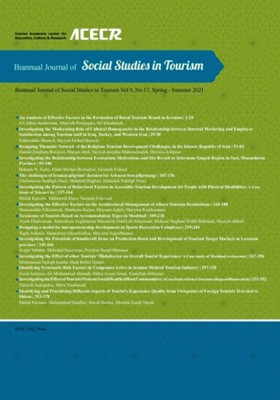Investigating the Moderating Role of Cultural Homogeneity in the Relationship between Internal Marketing and Employee Satisfaction among Tourism staff in Iraq, Turkey, and Western Iran,
Subject Areas :
Fakhrodin Maroofi
1
*
,
Seyed Farhad Hosseini
2
![]()
1 -
2 - Razi University
Keywords: Internal Marketing#Job Satisfaction#Cultural Homogeneity#Tourism ,
Abstract :
The role of internal marketing in employee satisfaction has been empirically investigated in more than 200 researches so far. However, few studies have addressed the role of employees in cultural backgrounds. Taking this literature gap into consideration, this descriptive survey study sought to survey the moderating effect of cultural homogeneity on the relationship between internal marketing and employee satisfaction in the workplace. The study's statistical population comprised the Iranian, Iraqi, Turkish, and Kurdish tourism employees, out of which 338 staff were selected via the available sampling method. The required data were collected through library research and questionnaires. Confirmatory factor analysis and structural equation modeling were used to analyze the collected data. The results of the study indicated that there was a positive correlation between internal marketing and employee satisfaction (0.53). Moreover, the study's practical and theoretical findings confirmed that cultural homogeneity could further enhance internal marketing and employee satisfaction (0.678).
·
پیرس، فیلیپ. (1395). رفتار گردشگر. ترجمه دکتر حمید ضرغام بروجنی و همکاران. چاپ دوم. تهران: مهکامه.
حاج علیلو، بهزاد و نکوئی صدری، بهرام. (1390). ژئوتوریسم. تهران: انتشارات دانشگاه پیام نور کشور.
رستگار، حمیدرضا و صرافان، امیرمحمد. (1393). «نگاهی بر نقش و اهمیت انگیزه گردشگران در توسعه گردشگری پایدار در ایران». دومین همایش ملی گردشگری، جغرافیا و محیط زیست پایدار، همدان: 22 آبان.
سکاران، اوما. (1390). روشهای تحقیق در مدیریت. ترجمه محمد صائبی و محمود شیرازی. چاپ هشتم. تهران: مرکز آموزش مدیریت دولتی ریاست جمهوری.
عليزاده ثاني، محسن؛ فراهانی، بنفشه و احمدی خطیر، طاهره. (1393). «عوامل انگيزشي گردشگري سلامت در چشمههاي آبگرم استان مازندران (مطالعه موردي رامسر و لاويج)». مجله برنامهریزی و توسعه گردشگری سال سوم. شماره 11. صص 33 - 52.
قادری، اسماعیل و مطهر، سیده مهسا. (1392). «بررسی عامل کششی انگیزاننده گردشگران در انتخاب مقصد، مقایسه مقاصد داخلی و خارجی (مطالعه موردی شهر تهران)». فصلنامه اقتصاد و مدیریت شهري. شماره2. 15 الی 29.
کال، ام. ؛ بورگ، و. و گال، جی. پی. (1394). روشهای تحقیق کمّی و کیفی در علوم تربیتی و روانشناسی (جلد اول). مترجمان: دکتر احمدرضا نصر، دکتر حمیدرضا عریضی، دکتر محمود ابوالقاسمی، محمدجعفر پاک سرشت، دکتر علیرضا کیامنش، دکتر خسرو باقری، دکتر محمد خیر، دکتر منیجه شهنی ییلاق و دکتر زهره خسروی به اهتمام دکتر احمد رضا نصر. چاپ دهم. تهران: سمت.
گی، چاک وای و فایو-سولا، اداردو. (1390). جهانگردی در چشمانداز جامع. ترجمه علی پارساییان و سید محمد اعرابی. چاپ هفتم. تهران: انتشارات دفتر پژوهشهای فرهنگی.
نکوئی صدری، بهرام. (1392). گزارش دوره فشرده آموزشی مدیریت و برنامهریزی اکوتوریسم در دانشگاه ملّی فیجی. تهران: سازمان بهرهوری ایران.
نکوئی صدری، بهرام. (۱۳۸۵). «طبیعت رویکردی نو در گردشگری». مجموعه مقالات همایش علمی یک روزه، بررسی توانمندیها، موانع و مشکلات و راههای توسعه گردشگری در آذربایجان شرقی، سازمان میراث فرهنگی صنایع دستی و گردشگری استان آذربایجان شرقی. تبريز: هتل پارس تبریز.
وب سایت اداره کل حفاظت از محیط زیست مازندران. (اردیبهشت 1399). مناطق چهارگانه-- قابل دسترسی آنلاین در لینک: https://mazandaran.doe.ir/portal/home/?976472
Aicher, T. J., Brenner, J., &Eddosary, M. (2015). Individuals’ motivation to participate in sport tourism: A self-determination theory perspective. International Journal of Sport Management, Recreation and Tourism, 18, 56-81.
Allan, M., (2012). Geotourism: Toward a better understanding of motivations for a geotourism experience, aSelf-Determination Theory perspective. Germany: LAP Lambert Academic Publishing, Saarbrucken.
Craike, M. (2008). Application of self-determination theory to a study of the determinants of regular participation in leisure-time physical activity. World Leisure Journal, 50(1), 58-69.
Deci, E. L., & Ryan, R. M. (2000). The" what" and" why" of goal pursuits: Human needs and the self-determination of behavior. Psychological inquiry, 11(4), 227-268.
Deci, E., L., Ryan, R.M. (1985). Intrinsic motivation and self-determination in human behavior. NewYork: Plenum Press.
Fennell, David A.(2015). Ecotourism, (the fourth edition); Taylor & Francis Ltd.
Honey, M. (1999). Ecotourism and Sustainable Development: Who Owns Paradise? Washington DC: Island Press.
Jafari, J.(2000) .Encyclopedia of Tourism. New York: Rutledge.
Jang, S., Bai, B. H., Clark, W. and Chi, M. E. (2009). Affect, travel motivation, and travel intention: A senior market. Journal of Hospitality & Tourism Research, 33(1), 51-73.
Klenosky, D. B. (2002). The “pull” of tourism destinations: A means-ends investigation. Journal of Travel Research, 40(4), 385–395.
Larsen, S., Øgaard, T., &Brun, W. (2011). Backpackers and mainstreamers: Realities and myths. Annals of Tourism Research, 38(2), 690-707.
Ma, A. T., Chow, A. S., Cheung, L. T., & Liu, S. (2018). Self-determined travel motivation and environmentally responsible behaviour of Chinese visitors to national forest protected areas in South China. Global ecology and conservation, 16.Retrieved from https://doi.org/10.1016/j.gecco.2018.e00480.
Markland, D., & Tobin, V. (2004). A modification to the behavioural regulation in exercise questionnaire to include an assessment of amotivation. Journal of Sport and Exercise Psychology, 26 (2), 191-196.
Maslow, A. H. (1970). Motivation and Personality. New York: Harper & Row.
Pearce, P.L.(2005). Tourist behavior: Themes and Conceptual Schemes. Clevedon, UK: Channel view.
Pearce, P. L., & Packer, J. (2013). Minds on the move: New links from psychology to tourism. Annals of Tourism Research, 40, 386-411.
Ramírez, F., & Santana, J. (2019). Environmental Education and Biodiversity Conservation. In: Ramírez, F., & Santana, J. (Eds.) Environmental Education and Ecotourism (pp. 7-11). Springer, Cham.
Shavanddasht, M. &Karubi, M.&Sadry B.N. (2017) ‘An Examination Of The Relationship Between Cave Tourists’ Motivations And Satisfaction: The Case Of Alisadr Cave, Iran’, GeoJournal of Tourism and Geosites, no. 2, vol. 20, p.165-176.
Wu,M. ,& Pearce P. (2014). Chinese recreational vehicle users in Australia: A Ethnographic Study Of Tourist Motivation. TourismManagement, 43:22-35.
Zhang, Y., Cole, Sh., Ricci, P., Gao, J. (2017). Context-Based Leisure Travel Facilitation among People with Mobility Challenges: A Self-Determination Theory Approach. Journal of Travel Research, Volume: 58 issue: 1, 42-62
https://doi.org/10.1177/0047287517741004

